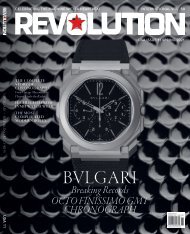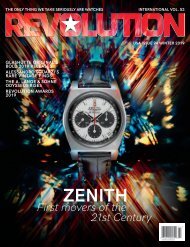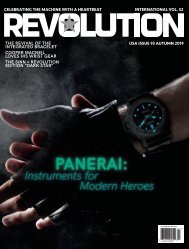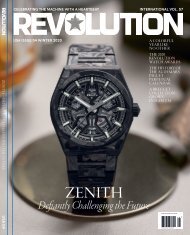Create successful ePaper yourself
Turn your PDF publications into a flip-book with our unique Google optimized e-Paper software.
STELLA BY STARLIGHT<br />
I remember a Rolex Passion Meeting<br />
in Maastricht many years ago. As is<br />
the custom at such events, there was<br />
a centerpiece table that was used as a<br />
show-and-tell platform upon which<br />
collectors set out their treasures. There<br />
were the usual line-ups of MilSubs,<br />
Comex, Newmans and Submariners<br />
of every vintage from 1950s Big<br />
Crowns to 1970s Maxi dials. It was the<br />
era of the explosion in international<br />
interest in vintage Rolex, which was<br />
almost entirely focused on steel sports<br />
watches. And then somebody opened a<br />
watch roll of Stella-dialed Day-Dates<br />
and so the bar was set for precious<br />
metal Rolex; a sector that steadily<br />
grows even until today.<br />
The Stella dials were introduced in the 1800 plexi-glass<br />
series Day-Dates and Rolex continued using them well<br />
into the sapphire-era 18000 series watches of the 1980s.<br />
The dials were available in a kaleidoscope of bright colors.<br />
At the time this was a bold move for Rolex, who were seen<br />
as conservative in many ways. The rich colored dials were<br />
created by building up layers of laquer to give a high-gloss<br />
finish. In the early days of internet 1.0, people would often<br />
refer to these dials as enamel or porcelain, but they were<br />
neither. There are so many different colors made, often the<br />
same color but in different shades. Take green for example.<br />
There were three shades — ‘Forest’, ‘Peppermint’ and<br />
‘Seafoam’. Stella dials were made with both applied baton<br />
markers and the classic “eight plus two” diamond set<br />
hours. Which is the most rare is a matter of opinion, but<br />
there is no argument that they are all beautiful dials.<br />
STONE AGE<br />
One of the most challenging manufacturing<br />
processes for watch brands is the production of<br />
stone dials. Working with stone is difficult as it<br />
is incredibly hard and the resulting finished piece<br />
is very thin. This leads to a large failure rate with the<br />
brittle stone slivers being very prone to cracking. One of<br />
the appealing aspects of stone dials, however, is the unique<br />
nature of each one. I spoke about this in the last installment<br />
of this series regarding the Daytona. The Day-Date used<br />
considerably more types of stone for its dials and I’m not<br />
sure anybody, other than Rolex, could compile a thoroughly<br />
exhaustive list of all the stones used in the Day-Date.<br />
However, what follows is about as close as it is possible to<br />
get with full access to the Rolex archive.<br />
This page<br />
ADay-Date<br />
1803 Stella Dial<br />
monikered the<br />
“Incredible Hulk”,<br />
usinggreenlacquer<br />
that was applied<br />
layer upon layer<br />
to give it that<br />
glossy finish.<br />
The 1803<br />
“Doraemon”<br />
Stella dial was<br />
named for the<br />
Japanese cartoon<br />
character which<br />
was highly popular<br />
during the era.<br />
Opposite<br />
The 1803<br />
“Firefighter” Stella<br />
dial. The vermillion<br />
tone of the dial<br />
reminds one of the<br />
bakelite material<br />
that was a common<br />
use in homewares.<br />
152 VINTAGE











